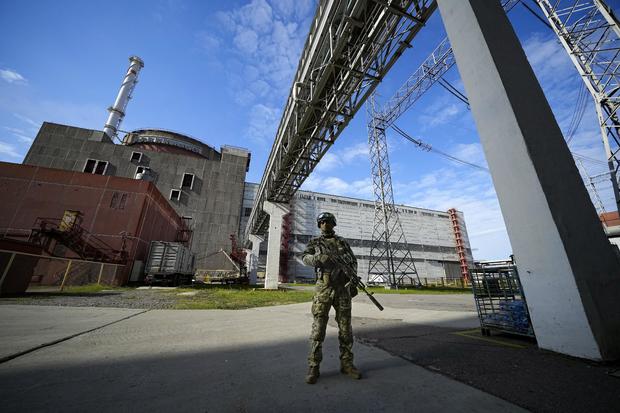Ukraine’s Zaporizhzhia Nuclear Power Plant, Europe’s largest atomic power station, spent hours operating on emergency diesel generators Monday after losing its external power supply for the seventh time since Russia’s full-scale invasion of its neighbor, the head of the U.N. nuclear watchdog said.
“The nuclear safety situation at the plant (is) extremely vulnerable,” Rafael Grossi, head of the International Atomic Energy Agency, said in a tweet.
Hours later, national energy company Ukrenergo said on Telegram that it had restored the power line that feeds the plant.
But for Grossi, it was another reminder of what’s at stake at the Russian-occupied plant which has seen shelling close by.
“The recurrence of blackouts is clearly not sustainable. This is the seventh time the biggest nuclear power plant in Europe is on emergency generators. The time to agree on the protection of the plant is now. It is not impossible. The entire world is looking,” Grossi, who is traveling in China, told CBS News’ Pamela Falk on Monday morning.
The plant’s six nuclear reactors, which are protected by a reinforced shelter able to withstand an errant shell or rocket, have been shut down. But a disruption in the electrical supply could disable cooling systems that are essential for the reactors’ safety even when they are shut down. Emergency diesel generators, which officials say can keep the plant operational for 10 days, can be unreliable.
Grossi is planning to propose a protocol to protect the plant from shelling. The agency has tried to secure an agreement for a demilitarized zone established around the sprawling plant compound, which has been hit by rockets several times and had its connection to Ukraine’s power grid cut repeatedly, forcing it to rely on the emergency generators.
“We must avoid catastrophe,” Grossi said in March, when he made his second visit to the site.
“It is obvious that this area is facing perhaps a more dangerous phase. We have to step up our efforts to get to some agreement of the protection of the plant,” he told reporters at the time.

AP
Fighting, especially artillery fire, around the plant has fueled fears of a disaster like the one at Chernobyl, in northern Ukraine, in 1986. Then, a reactor exploded and spewed deadly radiation, contaminating a vast area in the world’s worst nuclear catastrophe.
Energoatom, Ukraine’s state nuclear company, blamed Russian shelling for the loss of the last high-voltage transmission line to the plant in Russian-occupied southern Ukraine, about 500 kilometers (300 miles) from Kyiv. It was not possible to independently verify that claim.
The facility is “on the verge of a nuclear and radiation accident,” Energoatom warned. Once the power line was restored, Energoatom described the situation as “stabilized.”
Grossi said it was the seventh time the plant had lost its outside power supply since Russia’s full-scale invasion in February 2022.
Ukraine believes the only way to secure the plant is by returning it to Ukrainian control, with IAEA inspectors present. “The Russians must withdraw the military personnel,” Ukraine’s U.N. ambassador Sergiy Kyslytsya told CBS News on Monday.
The Zaporizhzhia Nuclear Power Plant is one of the 10 biggest atomic power stations in the world.
Russian officials have begun training for a planned evacuation from the plant of 3,100 staff and their families, a representative of Energoatom said last week. The plant employed around 11,000 staff before the war, some 6,000 of whom remain at the site and in the surrounding town of Enerhodar.
More Russian military units have been arriving at the site and are mining it, the representative told The Associated Press, speaking on condition of anonymity due to security concerns.
Meanwhile, the governor of Russia’s Belgorod region, which borders Ukraine, said that a Ukrainian Armed Forces saboteur group entered the local town of Graivoron, about five kilometers (three miles) from the border, which also came under Ukrainian artillery fire.
Gov. Vyacheslav Gladkov said Russian forces “are taking the necessary measures to liquidate the enemy.” He didn’t elaborate.
But Ukrainian military intelligence officials didn’t confirm that Kyiv had deployed saboteurs and claimed that Russian citizens seeking regime change in Moscow were behind the Graivoron attack.
Ukraine intelligence representative Andrii Cherniak said Russian citizens belonging to groups calling themselves the Russian Volunteer Corps and the “Freedom of Russia” Legion were behind the assault.
The Russian Volunteer Corps claimed in a Telegram post it had crossed the border into Russia again.
The Russian Volunteer Corps describes itself as “a volunteer formation fighting on Ukraine’s side.” Little is known about the group, and it is not clear if it has any ties with the Ukrainian military.
The group was founded last August and reportedly consists mostly of anti-Putin far-right Russian extremists who have links with Ukrainian far-right groups.
Ukraine’s presidential office said Monday morning that at least three Ukrainian civilians were killed and 16 others were injured in Russian assaults over the previous 24 hours.
The Ukrainian Air Force reported that four out of 16 Russian missiles and all 20 drones launched against Ukrainian targets were shot down.
Military targets and public infrastructure in Dnipro, Ukraine’s fourth-largest city in the center of the country, were singled out for Russian attacks, which injured eight people, officials said. The Dnipro fire department was affected, and 12 houses, shops, and a kindergarten were damaged, according to Governor Serhii Lysak.
Pamela Falk contributed reporting.
